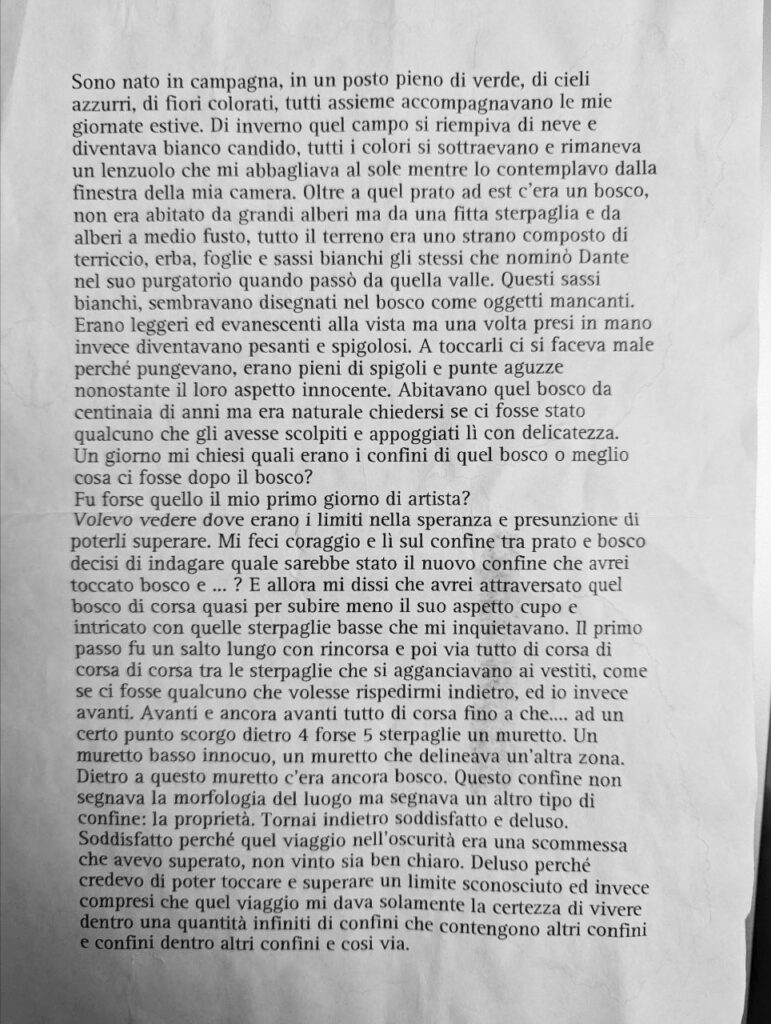Words
Close. Not here.
Interview
When did you realize that the work you were pursuing could be your path?
At the age of 5, I wondered what lay beyond the forest. That’s when I started running through the undergrowth to discover what I desired to know. I found a fence of white stone, the same stone that, years later, I realized Dante had described in the Divine Comedy dedicated to the landslide in the Lavini di Marco area. That little adventure revealed to me the path of my exploration: to traverse spaces to reach their boundaries. It was a performative experience because the fear and courage of crossing that field made me understand that the border was just one of the infinite boundaries I would have to confront.
What are the essential themes of your research?
I am fascinated by humanity as a whole. I am driven by intuitions that lead my work to seek paradox, the unexplored, and the overcoming of duality as the reasons for being in the world.
Strengths and challenges of your work and creative environment?
The strength of my work is being able to realize, in this life, a journey of materializing my intentions through art and showcasing the intuitions I have matured over the course of existences. The challenges are only perceptions of our way of being in the world; in truth, they represent the degree of attachment we have to the form we have assumed.
How do you relate to and see your work within the dynamics of contemporaneity?
I don’t believe my work is only inscribable in contemporaneity (in its sense of living or belonging to the present). I consider myself a traditionalist, in the sense that tradition reveals itself – a state of continuity between past, present, and future. I prefer to think of my research within an unfractionated path, without a beginning or end, like a long thread that connects multiple existences (mine and others’), rather than seeing myself inserted by fashion or interest in the context of those who can read and interpret contemporaneity.
What is your relationship with your native territory, Trentino, and how does this “origin” align with your research and the city where you currently live?
I love my places of origin, the valley and mountains bathed in the morning light; their beauty envelops me whenever I return, even for extended periods. But what fascinates me most is being born in a border area, a place that divides two geographical areas, two cultures. A place that is also a meeting point, an exchange zone between different ways of being and thinking. The state of my person and my artistic research, which divides and at the same time seeks to unite various forms of thought, aligns well with my Trentino origins precisely for this reason.
Interviewfrom the catalogue of the exhibition Vicino. Non qui.
Galleria Civica di Trento, 2018
The concept of the role between space and time
Giovanna Nicoletti
text from the catalogue Economia ed arte.
Dalla bottega al video,
Festival Economia, Trento, 2007
Using pixels as a measuring unit
Cristina Natalicchio
text from the catalogue
Mutations II Moving Stills, 2008
European Month of Photography,
Paris, Berlin, Bratislava, Luxembourg, Moscow, Rome and Vienna

This 2017 piece recollects
a performative action
I undertook at the age of
6 from memory.